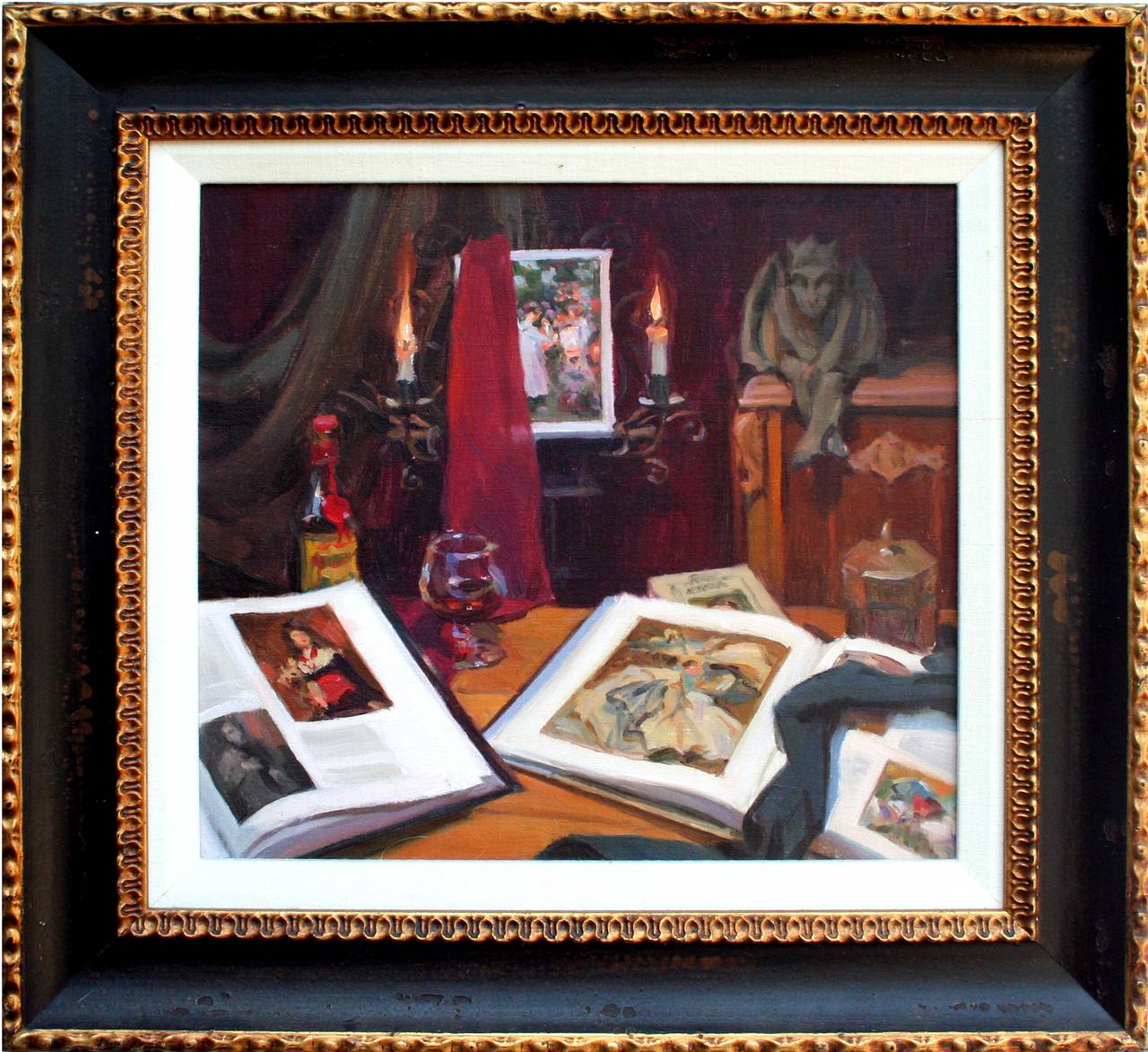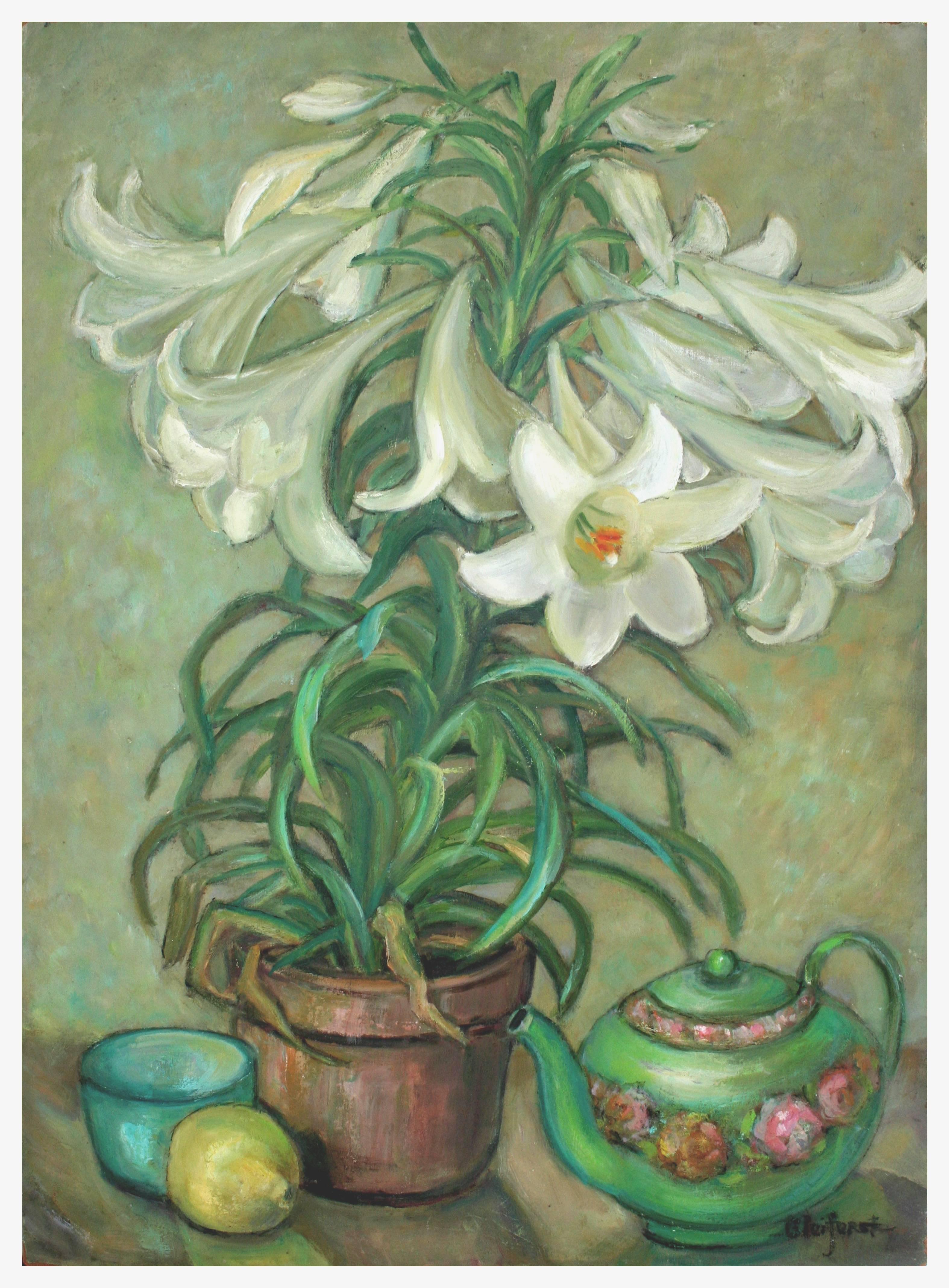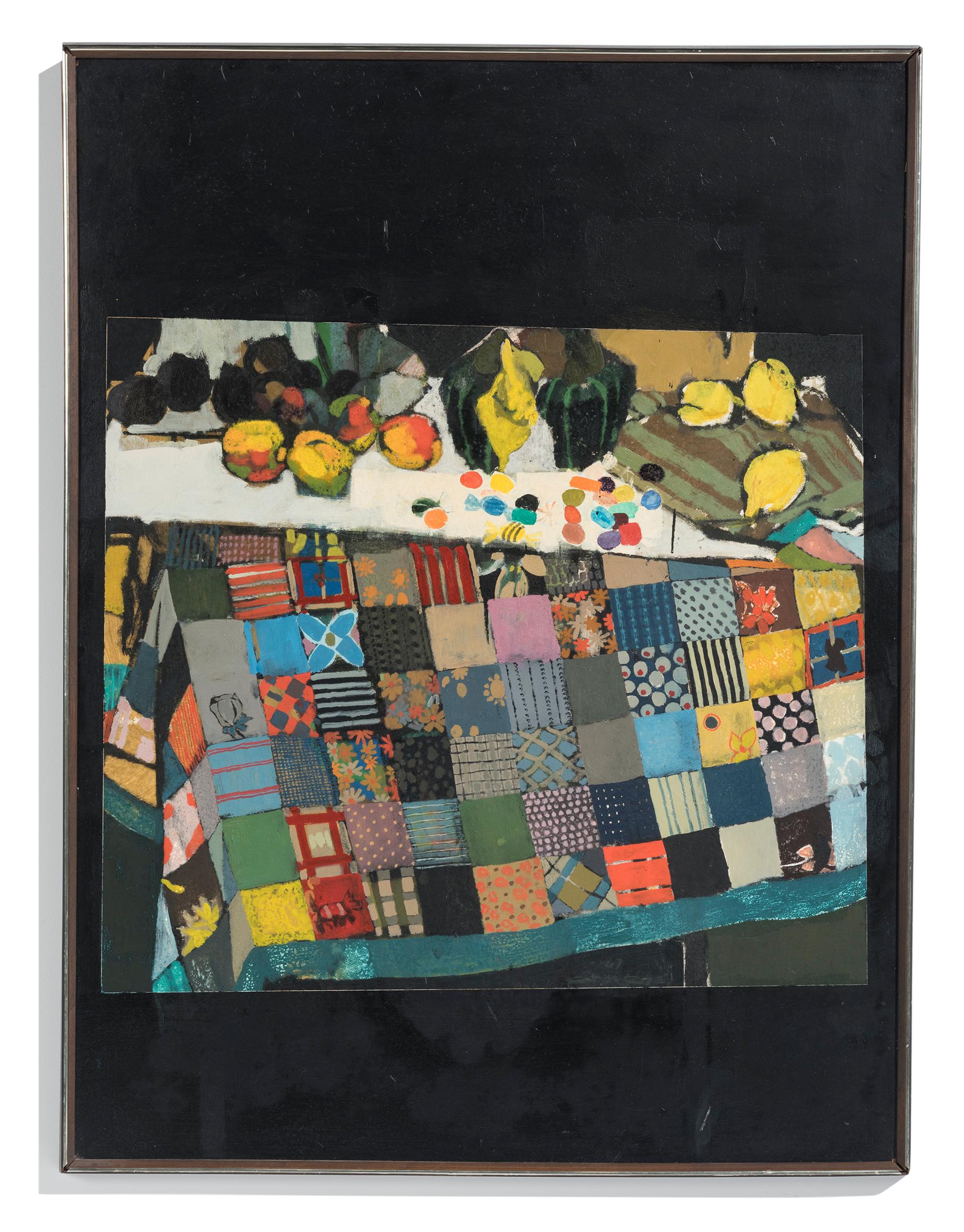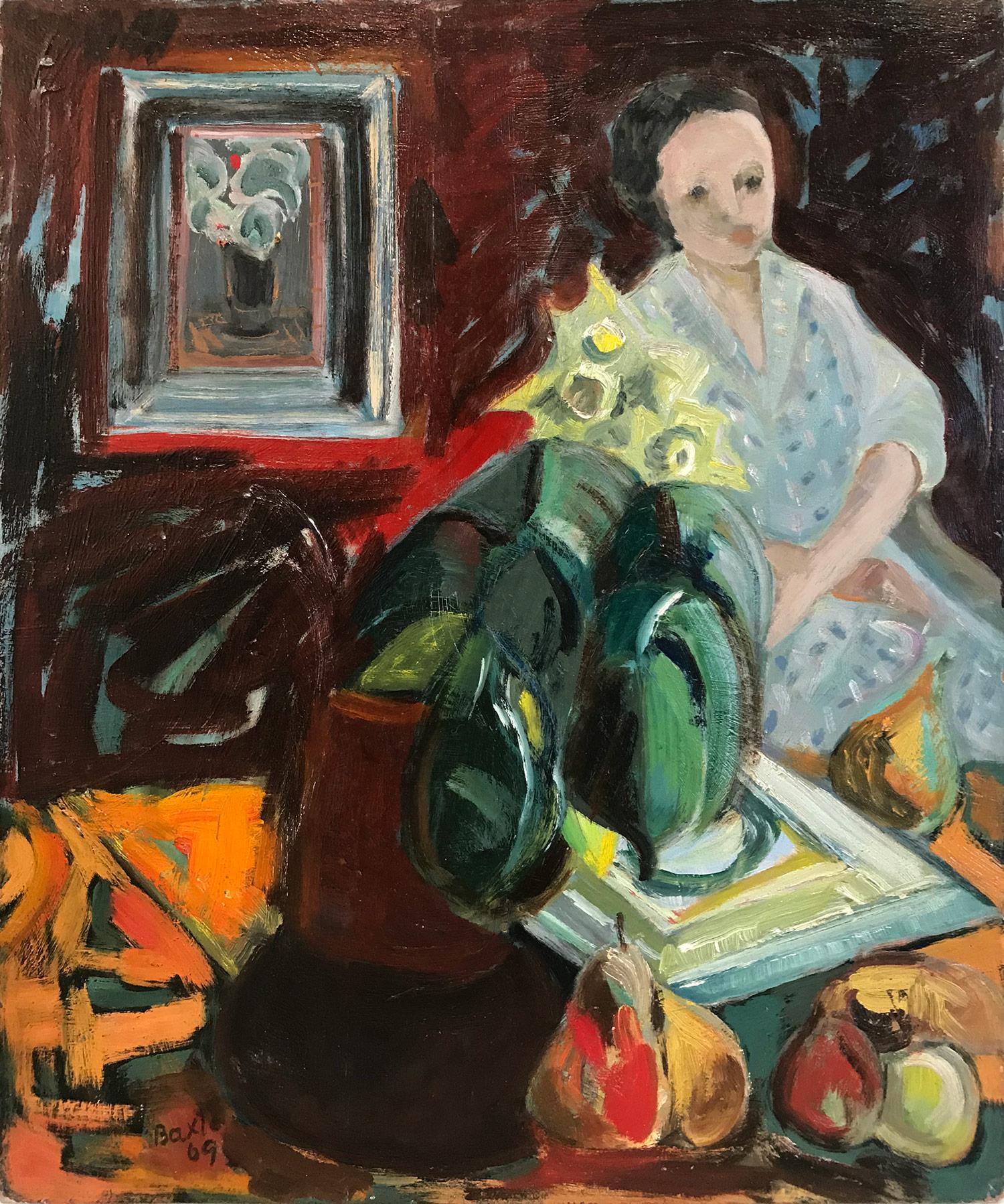Items Similar to Untitled (Lake House Window)
Want more images or videos?
Request additional images or videos from the seller
1 of 3
Harold HaydonUntitled (Lake House Window)ca. 1930s
ca. 1930s
About the Item
A quaint interior scene of clothes hanging & drying by artist Harold Haydon.
Harold Emerson Haydon was born in Fort William, Ontario, Canada in 1909. Haydon came to Chicago with his family in 1917 and became a naturalized American citizen in 1941. He attended the University of Chicago Lab School and the University of Chicago, where he earned a Bachelor’s Degree and Master’s Degree in Philosophy. He also studied painting at the Art Institute of Chicago. Haydon was a long-time Professor of Art at the University of Chicago, teaching from 1944-1975. He became an instructor at the Art Institute of Chicago from 1975-1981. Haydon also taught as an Adjunct Professor of Fine Arts at Indiana University from 1975-1982. In addition, Haydon served as the noted art critic of the Chicago Sun-Times from 1963-1985. He died in Chicago in 1994.
- Creator:Harold Haydon (1909 - 1994, American)
- Creation Year:ca. 1930s
- Dimensions:Height: 8 in (20.32 cm)Width: 8.25 in (20.96 cm)
- More Editions & Sizes:Framed: 11 3/4" x 12"Price: $1,500
- Medium:
- Period:
- Condition:
- Gallery Location:Chicago, IL
- Reference Number:1stDibs: LU2591213073202
Harold Haydon
Harold Emerson Haydon was born in Fort William, Ontario, Canada in 1909. Haydon came to Chicago with his family in 1917 and became a naturalized American citizen in 1941. He attended the University of Chicago Lab School and the University of Chicago, where he earned a Bachelor’s Degree and Master’s Degree in Philosophy. He also studied painting at the Art Institute of Chicago. Haydon was a long-time Professor of Art at the University of Chicago, teaching from 1944-1975. He became an instructor at the Art Institute of Chicago from 1975-1981. Haydon also taught as an Adjunct Professor of Fine Arts at Indiana University from 1975-1982. In addition, Haydon served as the noted art critic of the Chicago Sun-Times from 1963-1985. He died in Chicago in 1994.
About the Seller
5.0
Vetted Seller
These experienced sellers undergo a comprehensive evaluation by our team of in-house experts.
Established in 2000
1stDibs seller since 2023
13 sales on 1stDibs
Typical response time: <1 hour
- ShippingRetrieving quote...Ships From: Chicago, IL
- Return PolicyThis item cannot be returned.
More From This SellerView All
- Untitled (Martha’s Vineyard)By Francis ChapinLocated in Chicago, ILA colorful view of Martha's Vineyard (Depicting Edgartown's main street) by Francis Chapin, from around 1950. Francis Chapin, affectionately called the “Dean of Chicago Painters” by...Category
1950s American Modern Landscape Paintings
MaterialsMasonite, Oil
- Yellow Sky at MenemshaBy Francis ChapinLocated in Chicago, ILA colorful view of Menemsha in Martha's Vineyard by Francis Chapin, from around 1950. Francis Chapin, affectionately called the “Dean of Chicago Painters” by his colleagues, was one...Category
1950s American Modern Landscape Paintings
MaterialsMasonite, Oil
- Oak Bluffs, Mass. (Martha’s Vineyard)By Francis ChapinLocated in Chicago, ILA view of Oak Bluffs, MA on Martha's Vineyard by Francis Chapin, from around 1950. Francis Chapin, affectionately called the “Dean of Chicago Painters” by his colleagues, was one of...Category
1950s American Modern Landscape Paintings
MaterialsMasonite, Oil
- Untitled (Vineyard Harbor)By Francis ChapinLocated in Chicago, ILA colorful view of Martha's Vineyard by Francis Chapin, from the 1930s. Francis Chapin, affectionately called the “Dean of Chicago Painters” by his colleagues, was one of the city’s most popular and celebrated painters in his day. Born at the dawn of the 20th Century in Bristolville, Ohio, Chapin graduated from Washington & Jefferson College near Pittsburgh, Pennsylvania before enrolling at the Art Institute of Chicago in 1922. He would set down deep roots at the Art Institute of Chicago, exhibiting there over 31 times between 1926 and 1951. In 1927 Chapin won the prestigious Bryan Lathrop Fellowship from the Art Institute – a prize that funded the artist’s yearlong study trip to Europe. Upon his return to the United States, Chapin decided to remain in Chicago, noting the freedom Chicago artists have in developing independently of the pressure to conform to pre-existing molds (as was experienced by artists in New York, for example). Chapin became a popular instructor at the Art Institute, teaching there from 1929 to 1947 and at the Art Institute’s summer art school in Saugatuck, Michigan (now called Oxbow) between 1934 – 1938 (he was the director of the school from 1941-1945). A prolific painter, Chapin produced numerous works while traveling in Mexico, France, Spain, Saugatuck and Martha’s Vineyard, where he frequently spent summers and taught at the Old Sculpin Gallery there. Chapin was best recognized for his dynamic and vibrant images of Chicago during the 1930s and 40s. Chapin was a resident of the Old Town neighborhood where he lived and kept his studio on Menomonee Street for many years. Described as a “colorful figure, nearly 6 feet 6 inches tall, and thin, and usually wearing tweeds”, it is easy to imagine Chapin at work observing the busy street life of the city. In addition to his many exhibitions at the Art Institute of Chicago, Chapin’s work was shown during his lifetime at such institutions as the Pennsylvania Academy of Fine Arts, Philadelphia; the Corcoran Gallery, Washington, D.C.; the National Academy of Design, New York; the Museum of Modern Art, New York; the Whitney Museum of American Art, New York and the Carnegie Institute, Pittsburgh, among others. Francis Chapin’s paintings are represented in the collections the Art Institute of Chicago; the Friedman Collection, Chicago; the Butler Institute of American Art, Youngstown; the Denver Art Museum; the Everson Museum of Art, Syracuse; the Norton Museum of Art, West Palm Beach...Category
1930s American Modern Landscape Paintings
MaterialsMasonite, Oil
- Western View from Sun Deck on Ajax Mt, Aspen, Colo.By Harold HaydonLocated in Chicago, ILA small, colorful Modernist landscape painting by Harold Haydon, depicting "View NW from Sun Deck, Aspen, Colo, Ajax Mt.", dated 1955. This painting com...Category
1950s Modern Landscape Paintings
MaterialsOil
- Western View from Sun Deck on Ajax Mt, Aspen, Colo.By Harold HaydonLocated in Chicago, ILA small, colorful Modernist landscape painting by Harold Haydon, depicting "Western View from Sun Deck on Ajax Mt., Aspen, Colo.", dated 1955. This pain...Category
1950s American Modern Landscape Paintings
MaterialsOil
You May Also Like
- Ultra Realist Library Still-Life Books and Candles "Little Devil in the Details"By Ken DeWaardLocated in Soquel, CAUltra Realist Library Still-Life Books and Candles "Little Devil in the Details" Highly detailed library interior scene and still-life titled "Little Devil in the Detail" by Ken DeWaard (American, 20th-century). This intriguing artists performance in excellence piece, features realistically rendered books, paintings within paintings, candle light, and a devil or gargoyle sculpture. The artist creates a strong mood as well as interesting subject matter in this unique scene. Signed "Dewaard '99" upper right. Displayed in a wood frame. Image size, 13"H x 14"L. Frame: 20"H x 21"W x 2"D After receiving his Bachelor of Arts with honors, Ken began working in a commercial art studio in Chicago. He continued his studies at the American Academy of Art, where he studied with nationally recognized watercolorist, Irving Shapiro. Upon Irving's recommendation Ken joined the acclaimed Palette and Chisel Academy of Fine Art in Chicago, where he soon began studying with Scott Burdick as well as Dan Gerhartz...Category
1990s American Impressionist Interior Paintings
MaterialsMasonite, Oil
- Mid Century Lilies and Teapot Still LifeBy Helen Enoch GleiforstLocated in Soquel, CAGorgeous mid-century still life of a vase of white lilies next to a green teapot and lemon by listed California artist Helen Enoch Gleiforst (American, 19...Category
1950s American Impressionist Still-life Paintings
MaterialsMasonite, Oil
- Charles McGee Oil Painting "Squares and Things" African-American 1967By Charles McGeeLocated in Detroit, MI"Squares and Things" painted by the eminent artist, Charles McGee, literally breaths his African American heritage and his extraordinary vibrant use of colors. Provenance is The Arwin Galleries on Grand River in Detroit, Michigan - label on verso. This early painting of McGee's shows his mastery in creating a painting in the style of the French Impressionist Edouard Manet, "Still Life with Melon and Peaches" located in the National Gallery of Art, Washington, DC, and in the style of Fauvist/Expressionist painter Henry Matisse, "Still Life with Blue Tablecloth", located in the Hermitage Museum, Saint Petersburg, Russia. McGee makes the well-known genre of still life his own creating an exciting marvelous work incorporating the homely quilt - the powerful symbol of the African American road to safety from slavery - as his main focus. Quilts symbolize warmth, comfort, and as shown by the collection of quilts gathered by the artists in Gee's Bend the designs on the quilts hung outdoors at locations along the Underground Railroad showed fugitives the road north and to safety. "Squares and Things" was first shown at The Arwin Galleries, Inc., Detroit, Michigan, one of the stops along the Underground Railroad. This piece is signed by the artist, Charles McGee, and is an extraordinary example of his early work before he moved into Abstract Expressionism and his many sculptural works now located throughout Michigan. Several of these works are: "Noah's Ark: Genesis, 1984," on display at the Detroit Institute of Arts, his brilliant 2005 "Progression" a 45-foot wide aluminum sculpture at Beaumont Hospital, Royal Oak, Michigan, and his stunning 2016 "United We Stand" sculpture at the Charles H. Wright Museum of African American History . His genius can be seen in sculpture installments throughout the city of Detroit. . He was born into a family of sharecroppers. While helping his grandfather tend the land, "he observed firsthand the order and harmony that exists within nature." He had no formal schooling until moving to Detroit at age 10, where he found that "everything was on the move and it hasn’t slowed down yet." in 2017 he observed, "I learned something not being in school — because life is school . . .I learn something every time I move. Every time I go around a corner, something new is revealed to me.” McGee took advantage of the GI Bill to attend classes at the Society of Arts and Crafts, now the College for Creative Studies, Detroit, MI. Other College for Creative Studies (formerly Center for Creative Studies) faculty and graduates include Richard Jerzy, Harry Bertoia, Doug Chaing (currently director of Lucas Film), Stephen Dinehart (game maker, writer, designer connected with The David Lynch Foundation), Tyree Guyton (international artist), Herb Babcock, Jerome Feretti, Kevin Siembieda (writer, designer and publisher of role-playing games), Renee Radell, and Philip Pearlstein. After retiring from the Corps of Engineers, McGee spent 1968 studying art in Barcelona. Despite not knowing the language at the outset, he immersed himself in the culture and opened himself to a whole new range of experience that would play out in his artwork. "If you free yourself, you have this kind of opportunity to have those experiences, horizons, and new vistas." (per interview with Nick Sousanis author of a book on Charles McGee.) He returned to Detroit and curated "Seven Black Artists" at the Detroit Artists Market in 1969, which along with McGee himself, included Lester Johnson, Henri Umbaji King, Robert Murray, James Lee, Allie McGhee...Category
Late 20th Century American Modern Still-life Paintings
MaterialsOil, Masonite
- "Interior Scene with Figure" Expressionistic Style Oil Painting on MasoniteBy Michael BaxteLocated in New York, NYA strong modernist oil painting depicted in 1969 by Russian painter Michael Baxte. Mostly known for his abstracted figures on canvas or street scenes, this piece is a wonderful representation of his bold still life paintings, with expressive use of color, shape, and form. Later in his career, Baxte explores Expressionism, infusing both European and North American stylistic trends. This piece is from later in his career, but we can feel this underlying style throughout. Art measures 21.75 x 18 inches Michael Posner Baxte was born in 1890 in the small town of Staroselje Belarus, Russia. For the first half of the 19th century it was a center of the Chabad movement of Hasidic Jews, but this group was gone by the middle of the 19th century. By the time the Baxte family immigrated to the United States at the beginning of the 20th century, the Jewish population numbered only on the hundreds. The native language of the Baxte family was Yiddish. It is likely that the death of Michael Baxte’s father triggered the family’s immigration. Three older brothers arrived in New York between 1903 and 1905. Michael and his mother, Rebecca, arrived in 1907. By 1910 Michael, his mother, and brother, Joseph, were living in New Orleans and may have spent some time on a Louisiana plantation. Around 1912, Michael Baxte returned to Europe to study the violin. In 1914 he, his mother, and Joseph moved to New York City. Meanwhile, in Algeria, a talented young woman painter, Violette Mege, was making history. Since for the first time, a woman won the prestigious Beaux Art competition in Algeria. At first, the awards committee denied her the prize but, with French government intervention, Mege eventually prevailed. She won again 3 years later and, in 1916, used the scholarship to visit the United States of America. When Violette came to New York, she met Baxte, who was, by then, an accomplished violinist, teacher, and composer. Baxte’s compositions were performed at the Tokyo Imperial Theater, and in 1922 he was listed in the American Jewish Yearbook as one of the prominent members of the American Jewish community. As a music teacher he encouraged individual expression. Baxte stated, “No pupil should ever be forced into imitation of the teacher. Art is a personal experience, and the teacher’s truest aim must be to awaken this light of personality through the patient light of science.” By 1920 Michael Baxte and Violette Mege were living together in Manhattan. Although they claimed to be living as husband and wife, it seems that their marriage did not become official until 1928. On their “unofficial” honeymoon around 1917, in Algiers, Baxte confided to her his ambition to paint. There and later in New Mexico where the wonderful steeped sunlight approximates the coloring of Algiers, she taught him his heart’s desire. He never had any other teacher. She never had any other pupil. For ten years she devoted all her time, energy, and ambition to teaching, encouraging, inspiring him. Then in 1928, their mutual strivings were rewarded, as his works were being chosen as one of the two winners in the Dudensing National Competition for American Painters. Out of 150 artists from across the country participated in the Dudensing, and Michael Posner Baxte and, Robert Fawcett...Category
1960s Expressionist Interior Paintings
MaterialsMasonite, Oil
- Mid Century Figurative Nativity Scene w Hummel Figurines, Gloria in Excelsis DeoBy Helen Enoch GleiforstLocated in Soquel, CANativity scene on an architrave of a cathedral, done in the style of Hummel figurines by Helen Gleiforst (American, 1903-1997). Signed "Gleiforst" in t...Category
1950s American Impressionist Figurative Paintings
MaterialsMasonite, Oil
- Dining Room Interior SceneLocated in Soquel, CAInviting and warm interior dining room scene by S. Spencer (American, 20th Century). Signed and dated “S Spencer 83” in lower right corner. Unframed. Image size: 17.5 x 21.5.Category
1980s American Impressionist Interior Paintings
MaterialsOil, Masonite
Recently Viewed
View AllMore Ways To Browse
Family Interior
Vintage Window
Vintage Windows Windows
Vintage Window Art
1930 Interior
Dior House
Interior Window
Vintage Lake
Vintage Lakers
Painted Window Frames
Vintage Lake Art
Vintage Window Painting
Dior Chicago
Vintage Window Frames
Painted Vintage Windows
Lake House
Vintage Lake Painting
Lake Scene Painting






